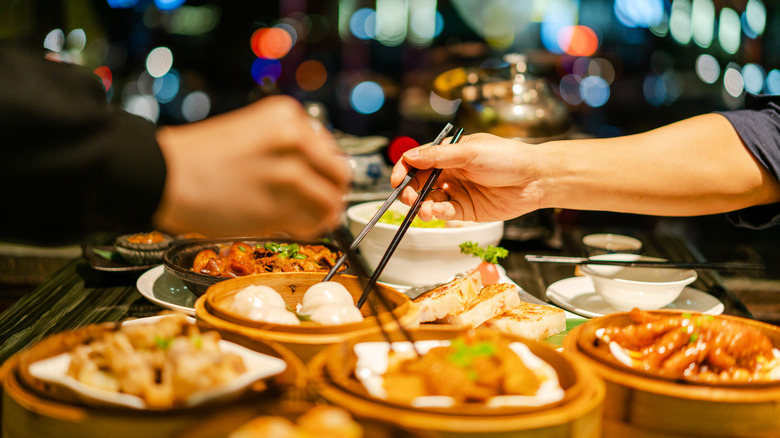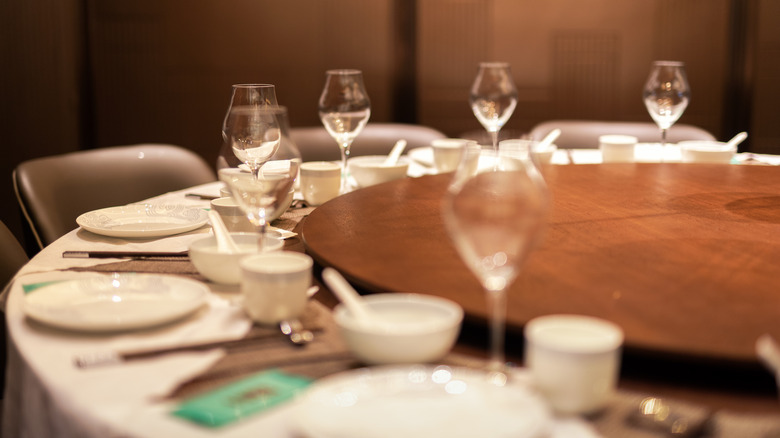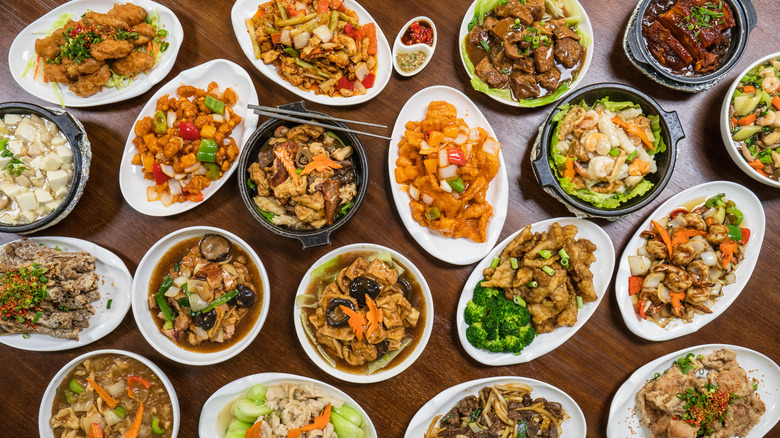Why You Should Avoid Ordering One Dish Per Person At Chinese Restaurants
We may receive a commission on purchases made from links.
If you grew up eating American-style Chinese food, then it's likely you're familiar with the standard combo plate setup — a dome-shaped mound of pork fried rice soaking up the gravy of five-spice beef and broccoli with an egg roll on the side. And while the particulars of each combo dish might vary — steamed rice instead of fried, General Tso's chicken in place of beef and broccoli, etc. — the spirit of the combo plate is alive and well in many Chinese eateries.
However, that combo plate is the antithesis of family-style eating, something that's very common in traditional Chinese dining. If Chinese combo platters are all you've ever known, you're missing out on a unique cultural experience if you're not sharing five or six platters of food with an equal number of people. In other words, you should be passing around those egg rolls and mounds of fried rice, allowing everyone at the table to share in the experience.
Family-style dining in a Chinese restaurant
While they don't exactly encourage sharing with family and friends, the average Chinese combo platter still has something to teach us — how to choose possible meals to order when it's time to eat Chinese food family-style. Most combo platters include some kind of rice or noodle dish, a protein dish, a veggie, and possibly an appetizer, like egg rolls or pork and seeds, with variations thereof, depending on the combo you order.
You can still have all of these foods and then some when you eat communally in a Chinese restaurant. The difference is each food will be assigned to its own platter. In other words, you'll have a plate of rice or noodles, a plate of protein, a plate of veggies, and an assortment of appetizers, also on their own plates. Think of the table as one big combo platter, and you have the right idea.
There's good reason to eat Chinese food (or any food really) together. Strong social bonds are forged over shared platters of pot stickers and kung pao chicken. Sociological research bears this out. According to a survey conducted by Oxford University, people who often eat with others are happier and more content with their lives than those who don't, and of those surveyed, 76% of them agreed that having a meal together was an excellent way to bring people together.
Possible menu items to share with friends and family
The most satisfying family-style dining experiences come from ordering a variety of diverse dishes that offer flavor and texture juxtapositions to each other. If you're not sure where to start with this, you can use restaurant's combo meals as a guide. Or, you can apply the five flavors concept — salty, sour, sweet, bitter, and umami — to the dishes you decide to order to up the variety quotient. For example, a plate of sweet and sour chicken or Szechuan beef gives you sweet, sour, and spicy (in the case of the beef). Broccoli with ginger and sesame combines bitter and umami flavors. Pork fried rice combines umami, salty, and sometimes sweet flavors in one dish.
As for appetizers, pork and seeds, with its spicy mustard and sweet ketchup brings together bitter, sweet, and umami, plus a spicy kick. Crab rangoon embraces plenty of sweet and umami flavors, as do many egg roll and spring roll recipes.
Of course, personal tastes, above all, dictate what you and yours will order, not the list above. However, the individual dishes you all order aren't as important as why you're ordering them. Eating a meal together offers you and your family and friends the opportunity to create delicious connections to each other, bound together by Chinese noodles and bottles of Kikkoman soy sauce.


